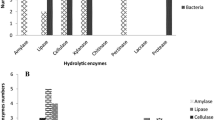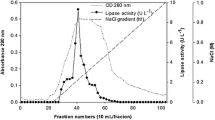Abstract
Lipolytic enzyme production of 150 isolated strains from samples of Lake Bogoria (Kenya) was examined. Among these, fifteen isolates were selected on the basis of their lipolytic activities and subjected to morphological and 16S rRNA gene sequencing analyses for their identification. All the microorganisms have been selected under culture conditions with pH ranges between 7–10 and temperatures of 37–55 °C. Most of them showed optimal growth at 37 °C and tolerated salinity up to 10% (w/v). Ten of the isolates were Gram-negative, nine of which were closely related to the Pseudomonas cluster and one to the Halomonas cluster sharing high similarity profile with Halomonas desiderata. The remaining Gram-positive isolates were closely related to the Bacillus cluster, and were grouped with Bacillus halodurans, Bacillus alcalophilus and Bacillus licheniformis. Four members of the Bacillus cluster and the Halomonas sp. produced lipolytic activity under alkaline conditions, while others did so at neutral pH values.
Similar content being viewed by others
References
Bell PJL, Nevalainen H, Morgan HW, Bergquist PL (1999) Rapid cloning of thermoalkalophilic lipases from Bacillus sp. using PCR. Biotechnol. Lett. 21: 1003–1006.
Franzmann PD, Wehmeyer U, Stackebrandt E (1988) Halomonadacea fam. nov., a new family of the class proteobacteria to accommodate the genera Halomonas and Deleya. Syst. Appl. Microbiol. 11: 16–19.
Gerhardt P, Murray RGE, Wood WA, Krieg NR (1994) Methods for General and Molecular Bacteriology. Washington, DC: American Society for Microbiology.
Gessesse A, Gashe BA (1997) Production of alkaline protease by an alkaliphilic bacteria isolated from an alkaline soda lake. Biotechnol. Lett. 19: 479–481.
Grant WD, Jones BE, Mwatha WE (1990) Alkaliphiles: ecology, diversity and applications. FEMS Microbiol. Rev. 75: 255–270.
Jaeger KE, Reetz MT (1998) Microbial lipases form versatile tools for biotechnology. Trends Biotechnol. 16: 396–403.
Johnson JL (1994) Similarity analysis of DNAs. In: Gerhart P, Murray RGE, Wood WA, Krieg NR, eds. Methods for General and Molecular Bacteriology. Washington, DC: American Society for Microbiology, pp. 655–682.
Jones BE, Grant WD, Duckworth AW, Owenson GG (1998) Microbial diversity of soda lakes. Extremophiles 2: 191–200.
Kouker G, Jaeger KE (1987) Specific and sensitive plate assay for bacterial lipases. Appl. Environ. Microbiol. 53: 211–213.
Lee D, Koh S, Kim K, Kim B, Choi H, Kim D, Suhartono M, Pyun Y (1999) Isolation and characterization of a thermophilic lipase from Bacillus thermoleovorans ID-1. FEMS Microbiol. Lett. 179: 393–400.
Litthauer D, Ginster A, van Eeden Skein E (2002) Pseudomonas luteola lipase: a new member of the 320-residue Pseudomonas lipase family. Enzyme Microb. Technol. 30: 209–215.
Logan NA, Berkeley CW (1984) Identification of Bacillus strains using the API System. J. Gen. Microbiol. 130: 1871–1882.
Maidak BL, Coloe JR, Lilburn TG, Parker Jr CT, Saxman PR, Stredwick JM, Garrity GM, Li B, Olsen GJ, Pramanik S, Schmidt TM, Tiedje JM (2000) The RDP (Ribosomal Database Project) continues. Nucl. Acids Res. 28: 173–174.
Marmur J (1961) A procedure for the isolation of deoxyribonucleic acid from microorganisms. J. Mol. Biol. 3, 208–218.
Martins R, Davids W, Al-Soud WA, Levander F, Rådström P, Hatti-Kaul R (2001) Starch-hydrolyzing bacteria from Ethiopian soda lakes. Extremophiles 5: 135–144.
Nthangeni M, Patterton, van Tonder A, Vergeer W, Litthauer D (2001) Over-expression and properties of a purified recombinant Bacillus licheniformis lipase: a comparative report on Bacillus lipases. Enzyme Microb. Technol. 28: 705–712.
Rathi P, Bradoo S, Saxena RK, Gupta R (2000) A hyperthermostable, alkaline lipase from Pseudomonas sp. with the property of thermal activation. Biotechnol. Lett. 22: 495–498.
Rees HC, Grant S, Jones B, Grant WD, Heaphy S (2003) Detecting cellulase and esterase enzyme activities encoded by novel genes present in environmental DNA libraries. Extremophiles 7: 415–421.
Saitou N, Nei M (1987) The neighbour-joining method: a new method for reconstructing phylogenetic trees. Mol. Biol. Evol. 4: 406–425.
Weisburg WG, Barns SM, Pelletier D, Lane DJ (1991) Ribosomal DNA amplification for phylogenetic study. J Bacteriol. 173: 697–703.
Author information
Authors and Affiliations
Rights and permissions
About this article
Cite this article
Vargas, V.A., Delgado, O.D., Hatti-Kaul, R. et al. Lipase-producing microorganisms from a Kenyan alkaline soda lake. Biotechnology Letters 26, 81–86 (2004). https://doi.org/10.1023/B:BILE.0000012898.50608.12
Issue Date:
DOI: https://doi.org/10.1023/B:BILE.0000012898.50608.12




